
llama.rn
React Native binding of llama.cpp
Stars: 671
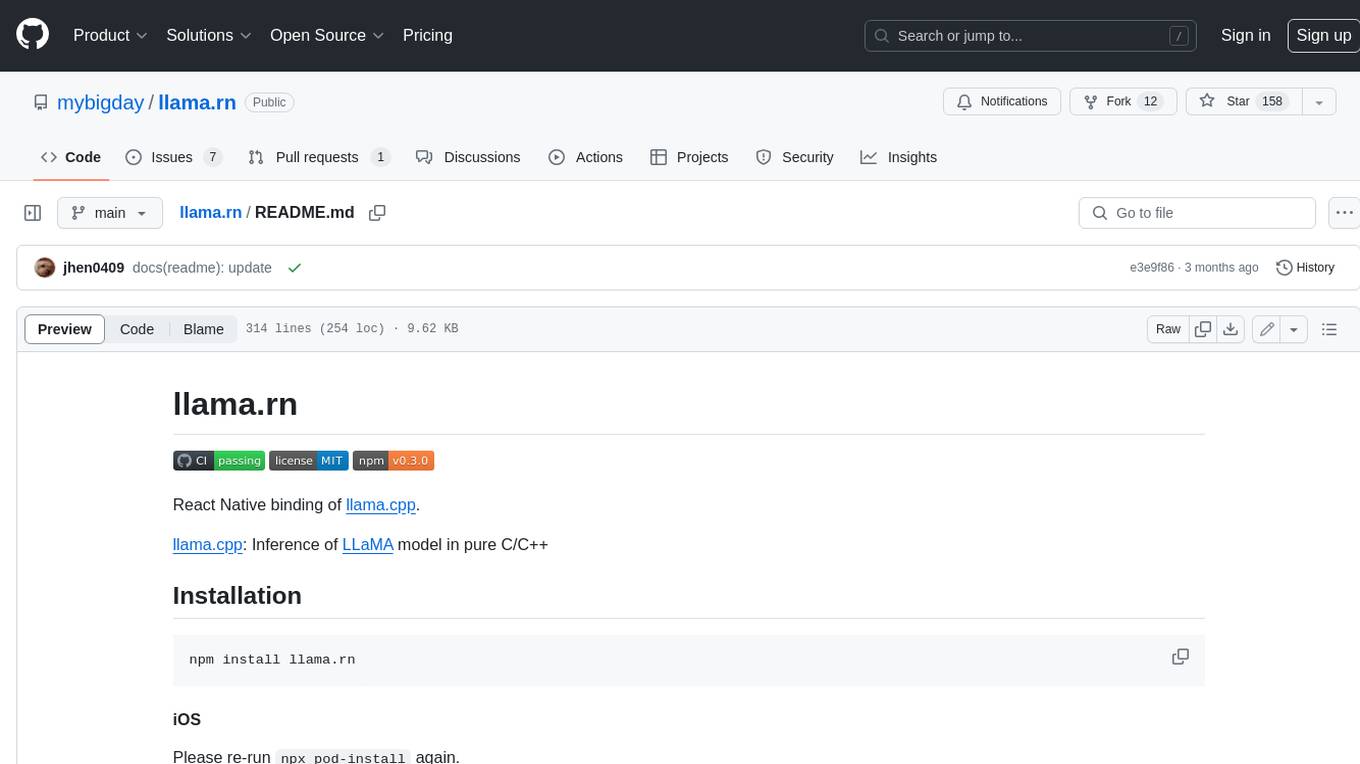
React Native binding of llama.cpp, which is an inference of LLaMA model in pure C/C++. This tool allows you to use the LLaMA model in your React Native applications for various tasks such as text completion, tokenization, detokenization, and embedding. It provides a convenient interface to interact with the LLaMA model and supports features like grammar sampling and mocking for testing purposes.
README:
React Native binding of llama.cpp.
llama.cpp: Inference of LLaMA model in pure C/C++
npm install llama.rnPlease re-run npx pod-install again.
By default, llama.rn will use pre-built rnllama.xcframework for iOS. If you want to build from source, please set RNLLAMA_BUILD_FROM_SOURCE to 1 in your Podfile.
Add proguard rule if it's enabled in project (android/app/proguard-rules.pro):
# llama.rn
-keep class com.rnllama.** { *; }
By default, llama.rn will use pre-built libraries for Android. If you want to build from source, please set rnllamaBuildFromSource to true in android/gradle.properties.
- Confirm the target device exposes an OpenCL-capable GPU (Qualcomm Adreno 700+ devices are currently supported & tested).
- Add
<uses-native-library android:name="libOpenCL.so" android:required="false" />to your app manifest so the loader can be loaded at runtime. - Configure
n_gpu_layers(> 0) when callinginitLlamato offload layers to the GPU. The native result exposesgpu,gpuDevice, andreasonNoGPUso you can confirm runtime behaviour.
You can search HuggingFace for available models (Keyword: GGUF).
For get a GGUF model or quantize manually, see quantize documentation in llama.cpp.
💡 You can find complete examples in the example project.
Load model info only:
import { loadLlamaModelInfo } from 'llama.rn'
const modelPath = 'file://<path to gguf model>'
console.log('Model Info:', await loadLlamaModelInfo(modelPath))Initialize a Llama context & do completion:
import { initLlama } from 'llama.rn'
// Initial a Llama context with the model (may take a while)
const context = await initLlama({
model: modelPath,
use_mlock: true,
n_ctx: 2048,
n_gpu_layers: 99, // number of layers to store in GPU memory (Metal/OpenCL)
// embedding: true, // use embedding
})
const stopWords = ['</s>', '<|end|>', '<|eot_id|>', '<|end_of_text|>', '<|im_end|>', '<|EOT|>', '<|END_OF_TURN_TOKEN|>', '<|end_of_turn|>', '<|endoftext|>']
// Do chat completion
const msgResult = await context.completion(
{
messages: [
{
role: 'system',
content: 'This is a conversation between user and assistant, a friendly chatbot.',
},
{
role: 'user',
content: 'Hello!',
},
],
n_predict: 100,
stop: stopWords,
// ...other params
},
(data) => {
// This is a partial completion callback
const { token } = data
},
)
console.log('Result:', msgResult.text)
console.log('Timings:', msgResult.timings)
// Or do text completion
const textResult = await context.completion(
{
prompt: 'This is a conversation between user and llama, a friendly chatbot. respond in simple markdown.\n\nUser: Hello!\nLlama:',
n_predict: 100,
stop: [...stopWords, 'Llama:', 'User:'],
// ...other params
},
(data) => {
// This is a partial completion callback
const { token } = data
},
)
console.log('Result:', textResult.text)
console.log('Timings:', textResult.timings)The binding's deisgn inspired by server.cpp example in llama.cpp:
-
/completionand/chat/completions:context.completion(params, partialCompletionCallback) -
/tokenize:context.tokenize(content) -
/detokenize:context.detokenize(tokens) -
/embedding:context.embedding(content) -
/rerank:context.rerank(query, documents, params) - ... Other methods
Please visit the Documentation for more details.
You can also visit the example to see how to use it.
llama.rn supports multimodal capabilities including vision (images) and audio processing. This allows you to interact with models that can understand both text and media content.
Images (Vision):
- JPEG, PNG, BMP, GIF, TGA, HDR, PIC, PNM
- Base64 encoded images (data URLs)
- Local file paths
- * Not supported HTTP URLs yet
Audio:
- WAV, MP3 formats
- Base64 encoded audio (data URLs)
- Local file paths
- * Not supported HTTP URLs yet
First, you need a multimodal model and its corresponding multimodal projector (mmproj) file, see how to obtain mmproj for more details.
import { initLlama } from 'llama.rn'
// First initialize the model context
const context = await initLlama({
model: 'path/to/your/multimodal-model.gguf',
n_ctx: 4096,
n_gpu_layers: 99, // Recommended for multimodal models
// Important: Disable context shifting for multimodal
ctx_shift: false,
})
// Initialize multimodal support with mmproj file
const success = await context.initMultimodal({
path: 'path/to/your/mmproj-model.gguf',
use_gpu: true, // Recommended for better performance
})
// Check if multimodal is enabled
console.log('Multimodal enabled:', await context.isMultimodalEnabled())
if (success) {
console.log('Multimodal support initialized!')
// Check what modalities are supported
const support = await context.getMultimodalSupport()
console.log('Vision support:', support.vision)
console.log('Audio support:', support.audio)
} else {
console.log('Failed to initialize multimodal support')
}
// Release multimodal context
await context.releaseMultimodal()const result = await context.completion({
messages: [
{
role: 'user',
content: [
{
type: 'text',
text: 'What do you see in this image?',
},
{
type: 'image_url',
image_url: {
url: 'file:///path/to/image.jpg',
// or base64: 'data:image/jpeg;base64,/9j/4AAQSkZJRgABAQEAYABgAAD...'
},
},
],
},
],
n_predict: 100,
temperature: 0.1,
})
console.log('AI Response:', result.text)// Method 1: Using structured message content (Recommended)
const result = await context.completion({
messages: [
{
role: 'user',
content: [
{
type: 'text',
text: 'Transcribe or describe this audio:',
},
{
type: 'input_audio',
input_audio: {
data: 'data:audio/wav;base64,UklGRiQAAABXQVZFZm10...',
// or url: 'file:///path/to/audio.wav',
format: 'wav', // or 'mp3'
},
},
],
},
],
n_predict: 200,
})
console.log('Transcription:', result.text)// Tokenize text with media
const tokenizeResult = await context.tokenize(
'Describe this image: <__media__>',
{
media_paths: ['file:///path/to/image.jpg']
}
)
console.log('Tokens:', tokenizeResult.tokens)
console.log('Has media:', tokenizeResult.has_media)
console.log('Media positions:', tokenizeResult.chunk_pos_media)-
Context Shifting: Multimodal models require
ctx_shift: falseto maintain media token positioning -
Memory: Multimodal models require more memory; use adequate
n_ctxand consider GPU offloading -
Media Markers: The system automatically handles
<__media__>markers in prompts. When using structured message content, media items are automatically replaced with this marker - Model Compatibility: Ensure your model supports the media type you're trying to process
llama.rn has universal tool call support by using minja (as Jinja template parser) and chat.cpp in llama.cpp.
Example:
import { initLlama } from 'llama.rn'
const context = await initLlama({
// ...params
})
const { text, tool_calls } = await context.completion({
// ...params
jinja: true, // Enable Jinja template parser
tool_choice: 'auto',
tools: [
{
type: 'function',
function: {
name: 'ipython',
description:
'Runs code in an ipython interpreter and returns the result of the execution after 60 seconds.',
parameters: {
type: 'object',
properties: {
code: {
type: 'string',
description: 'The code to run in the ipython interpreter.',
},
},
required: ['code'],
},
},
},
],
messages: [
{
role: 'system',
content: 'You are a helpful assistant that can answer questions and help with tasks.',
},
{
role: 'user',
content: 'Test',
},
],
})
console.log('Result:', text)
// If tool_calls is not empty, it means the model has called the tool
if (tool_calls) console.log('Tool Calls:', tool_calls)You can check chat.cpp for models has native tool calling support, or it will fallback to GENERIC type tool call.
The generic tool call will be always JSON object as output, the output will be like {"response": "..."} when it not decided to use tool call.
GBNF (GGML BNF) is a format for defining formal grammars to constrain model outputs in llama.cpp. For example, you can use it to force the model to generate valid JSON, or speak only in emojis.
You can see GBNF Guide for more details.
llama.rn provided a built-in function to convert JSON Schema to GBNF:
Example gbnf grammar:
root ::= object
value ::= object | array | string | number | ("true" | "false" | "null") ws
object ::=
"{" ws (
string ":" ws value
("," ws string ":" ws value)*
)? "}" ws
array ::=
"[" ws (
value
("," ws value)*
)? "]" ws
string ::=
"\"" (
[^"\\\x7F\x00-\x1F] |
"\\" (["\\bfnrt] | "u" [0-9a-fA-F]{4}) # escapes
)* "\"" ws
number ::= ("-"? ([0-9] | [1-9] [0-9]{0,15})) ("." [0-9]+)? ([eE] [-+]? [0-9] [1-9]{0,15})? ws
# Optional space: by convention, applied in this grammar after literal chars when allowed
ws ::= | " " | "\n" [ \t]{0,20}
import { initLlama } from 'llama.rn'
const gbnf = '...'
const context = await initLlama({
// ...params
grammar: gbnf,
})
const { text } = await context.completion({
// ...params
messages: [
{
role: 'system',
content: 'You are a helpful assistant that can answer questions and help with tasks.',
},
{
role: 'user',
content: 'Test',
},
],
})
console.log('Result:', text)Also, this is how json_schema works in response_format during completion, it converts the json_schema to gbnf grammar.
The session file is a binary file that contains the state of the context, it can saves time of prompt processing.
const context = await initLlama({ ...params })
// After prompt processing or completion ...
// Save the session
await context.saveSession('<path to save session>')
// Load the session
await context.loadSession('<path to load session>')- * Session is currently not supported save state from multimodal context, so it only stores the text chunk before the first media chunk.
The embedding API is used to get the embedding of a text.
const context = await initLlama({
...params,
embedding: true,
})
const { embedding } = await context.embedding('Hello, world!')- You can use model like nomic-ai/nomic-embed-text-v1.5-GGUF for better embedding quality.
- You can use DB like op-sqlite with sqlite-vec support to store and search embeddings.
The rerank API is used to rank documents based on their relevance to a query. This is particularly useful for improving search results and implementing retrieval-augmented generation (RAG) systems.
const context = await initLlama({
...params,
embedding: true, // Required for reranking
pooling_type: 'rank', // Use rank pooling for rerank models
})
// Rerank documents based on relevance to query
const results = await context.rerank(
'What is artificial intelligence?', // query
[
'AI is a branch of computer science.',
'The weather is nice today.',
'Machine learning is a subset of AI.',
'I like pizza.',
], // documents to rank
{
normalize: 1, // Optional: normalize scores (default: from model config)
}
)
// Results are automatically sorted by score (highest first)
results.forEach((result, index) => {
console.log(`Rank ${index + 1}:`, {
score: result.score,
document: result.document,
originalIndex: result.index,
})
})-
Model Requirements: Reranking requires models with
RANKpooling type (e.g., reranker models) -
Embedding Enabled: The context must have
embedding: trueto use rerank functionality - Automatic Sorting: Results are returned sorted by relevance score in descending order
- Document Access: Each result includes the original document text and its index in the input array
- Score Interpretation: Higher scores indicate higher relevance to the query
- jinaai - jina-reranker-v2-base-multilingual-GGUF
- BAAI - bge-reranker-v2-m3-GGUF
- Other models with "rerank" or "reranker" in their name and GGUF format
We have provided a mock version of llama.rn for testing purpose you can use on Jest:
jest.mock('llama.rn', () => require('llama.rn/jest/mock'))iOS:
- The Extended Virtual Addressing and Increased Memory Limit capabilities are recommended to enable on iOS project.
- Metal:
- We have tested to know some devices is not able to use Metal (GPU) due to llama.cpp used SIMD-scoped operation, you can check if your device is supported in Metal feature set tables, Apple7 GPU will be the minimum requirement.
- It's also not supported in iOS simulator due to this limitation, we used constant buffers more than 14.
Android:
- Currently only supported arm64-v8a / x86_64 platform, this means you can't initialize a context on another platforms. The 64-bit platform are recommended because it can allocate more memory for the model.
- The OpenCL backend is supported, but currently it limited to Qualcomm Adreno GPU and Q4_0 / Q6_K data types. Please check OpenCL backend for more details.
See the contributing guide to learn how to contribute to the repository and the development workflow.
- BRICKS: Our product for building interactive signage in simple way. We provide LLM functions as Generator LLM/Assistant.
- ChatterUI: Simple frontend for LLMs built in react-native.
- PocketPal AI: An app that brings language models directly to your phone.
-
llama.node: An another Node.js binding of
llama.cppbut made API same asllama.rn.
MIT
Made with create-react-native-library
Built and maintained by BRICKS.
For Tasks:
Click tags to check more tools for each tasksFor Jobs:
Alternative AI tools for llama.rn
Similar Open Source Tools

llama.rn
React Native binding of llama.cpp, which is an inference of LLaMA model in pure C/C++. This tool allows you to use the LLaMA model in your React Native applications for various tasks such as text completion, tokenization, detokenization, and embedding. It provides a convenient interface to interact with the LLaMA model and supports features like grammar sampling and mocking for testing purposes.
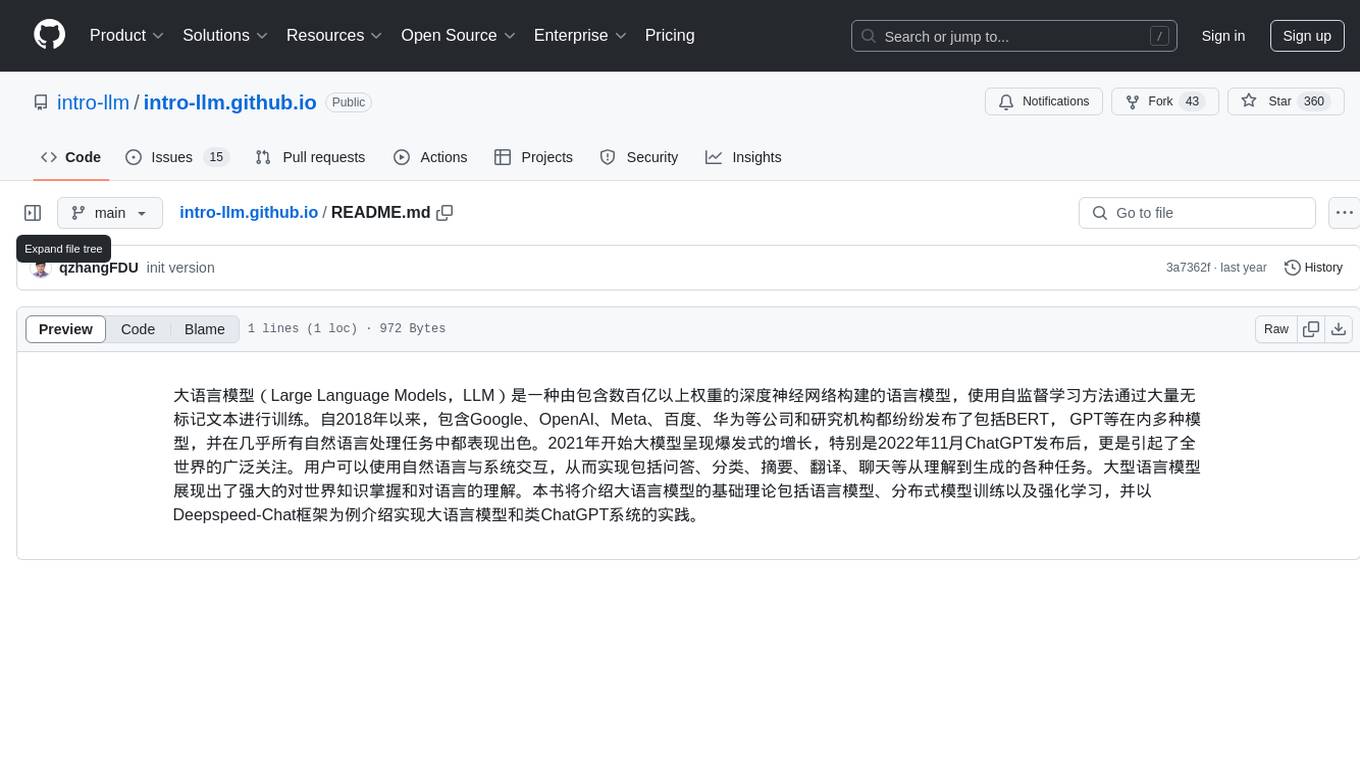
intro-llm.github.io
Large Language Models (LLM) are language models built by deep neural networks containing hundreds of billions of weights, trained on a large amount of unlabeled text using self-supervised learning methods. Since 2018, companies and research institutions including Google, OpenAI, Meta, Baidu, and Huawei have released various models such as BERT, GPT, etc., which have performed well in almost all natural language processing tasks. Starting in 2021, large models have shown explosive growth, especially after the release of ChatGPT in November 2022, attracting worldwide attention. Users can interact with systems using natural language to achieve various tasks from understanding to generation, including question answering, classification, summarization, translation, and chat. Large language models demonstrate powerful knowledge of the world and understanding of language. This repository introduces the basic theory of large language models including language models, distributed model training, and reinforcement learning, and uses the Deepspeed-Chat framework as an example to introduce the implementation of large language models and ChatGPT-like systems.
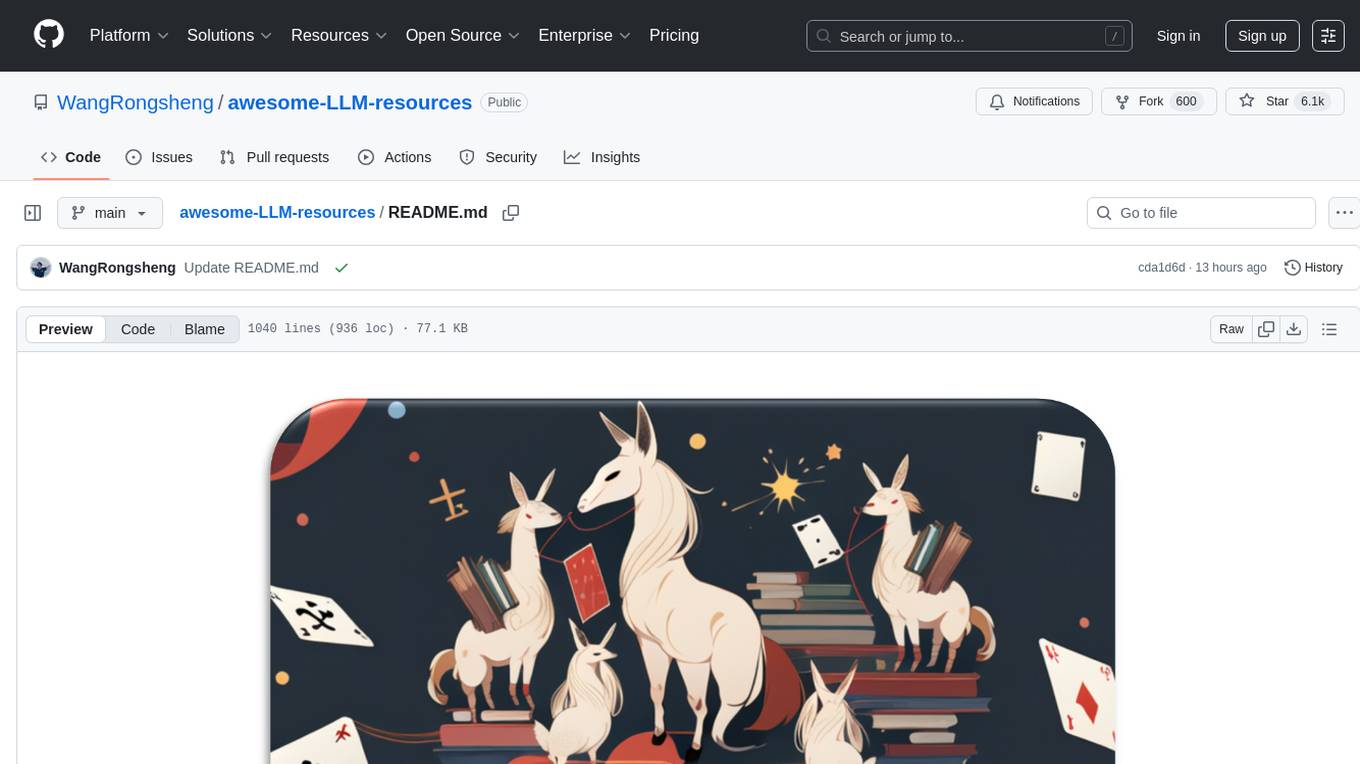
awesome-LLM-resources
This repository is a curated list of resources for learning and working with Large Language Models (LLMs). It includes a collection of articles, tutorials, tools, datasets, and research papers related to LLMs such as GPT-3, BERT, and Transformer models. Whether you are a researcher, developer, or enthusiast interested in natural language processing and artificial intelligence, this repository provides valuable resources to help you understand, implement, and experiment with LLMs.
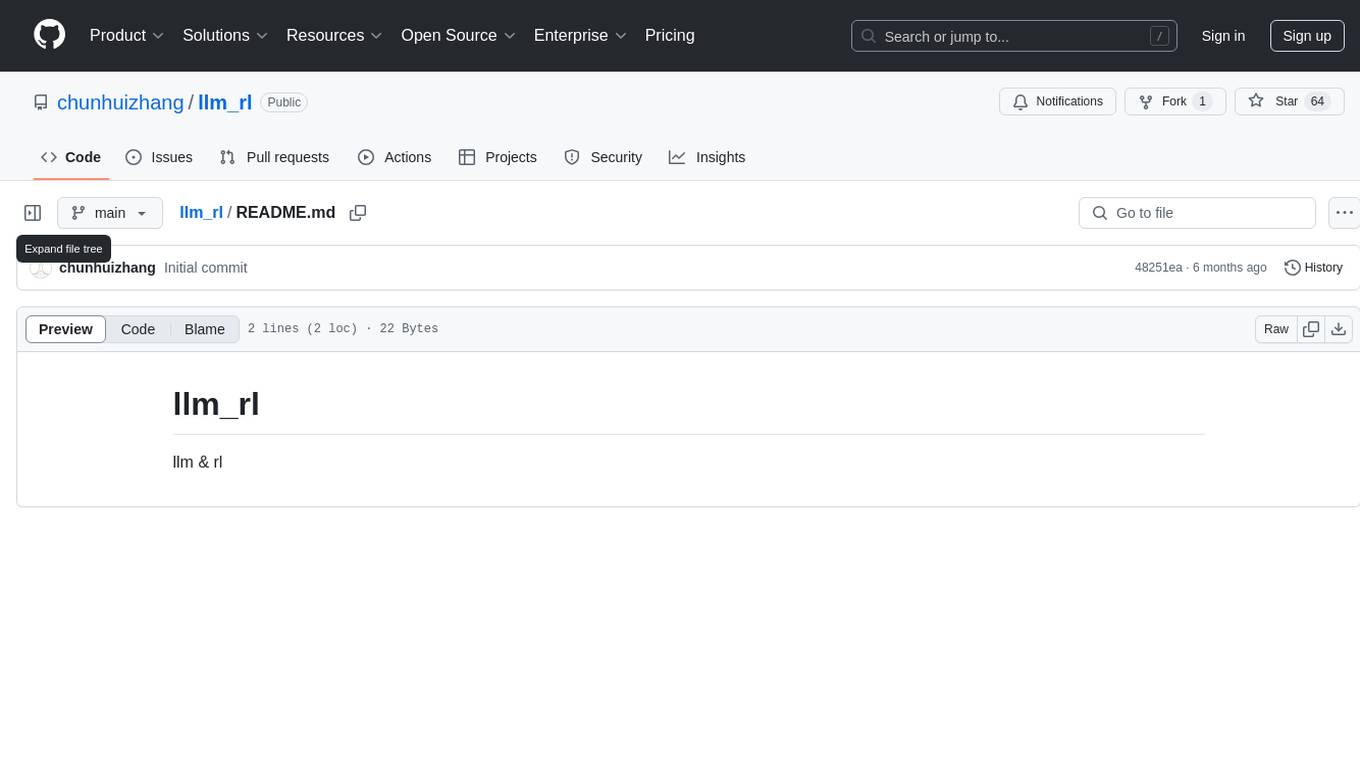
llm_rl
llm_rl is a repository that combines llm (language model) and rl (reinforcement learning) techniques. It likely focuses on using language models in reinforcement learning tasks, such as natural language understanding and generation. The repository may contain implementations of algorithms that leverage both llm and rl to improve performance in various tasks. Developers interested in exploring the intersection of language models and reinforcement learning may find this repository useful for research and experimentation.
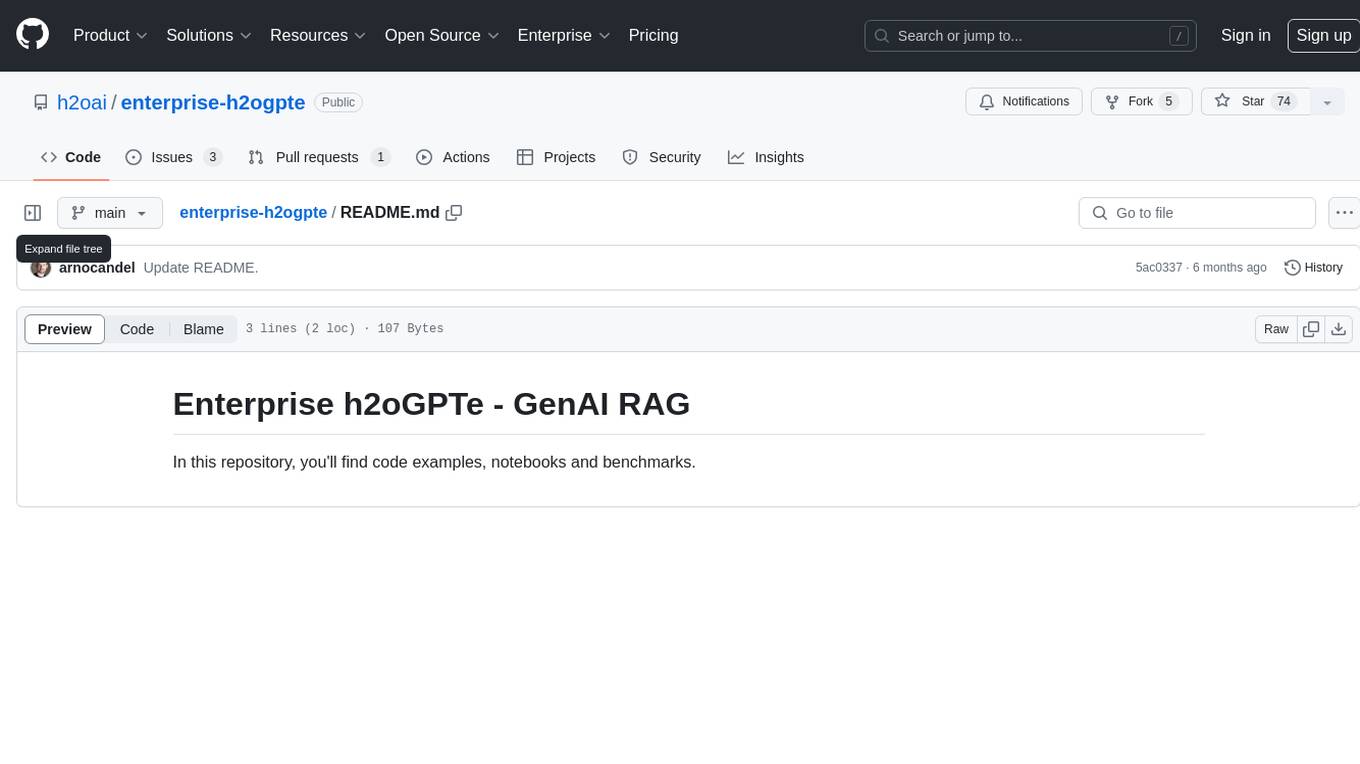
enterprise-h2ogpte
Enterprise h2oGPTe - GenAI RAG is a repository containing code examples, notebooks, and benchmarks for the enterprise version of h2oGPTe, a powerful AI tool for generating text based on the RAG (Retrieval-Augmented Generation) architecture. The repository provides resources for leveraging h2oGPTe in enterprise settings, including implementation guides, performance evaluations, and best practices. Users can explore various applications of h2oGPTe in natural language processing tasks, such as text generation, content creation, and conversational AI.
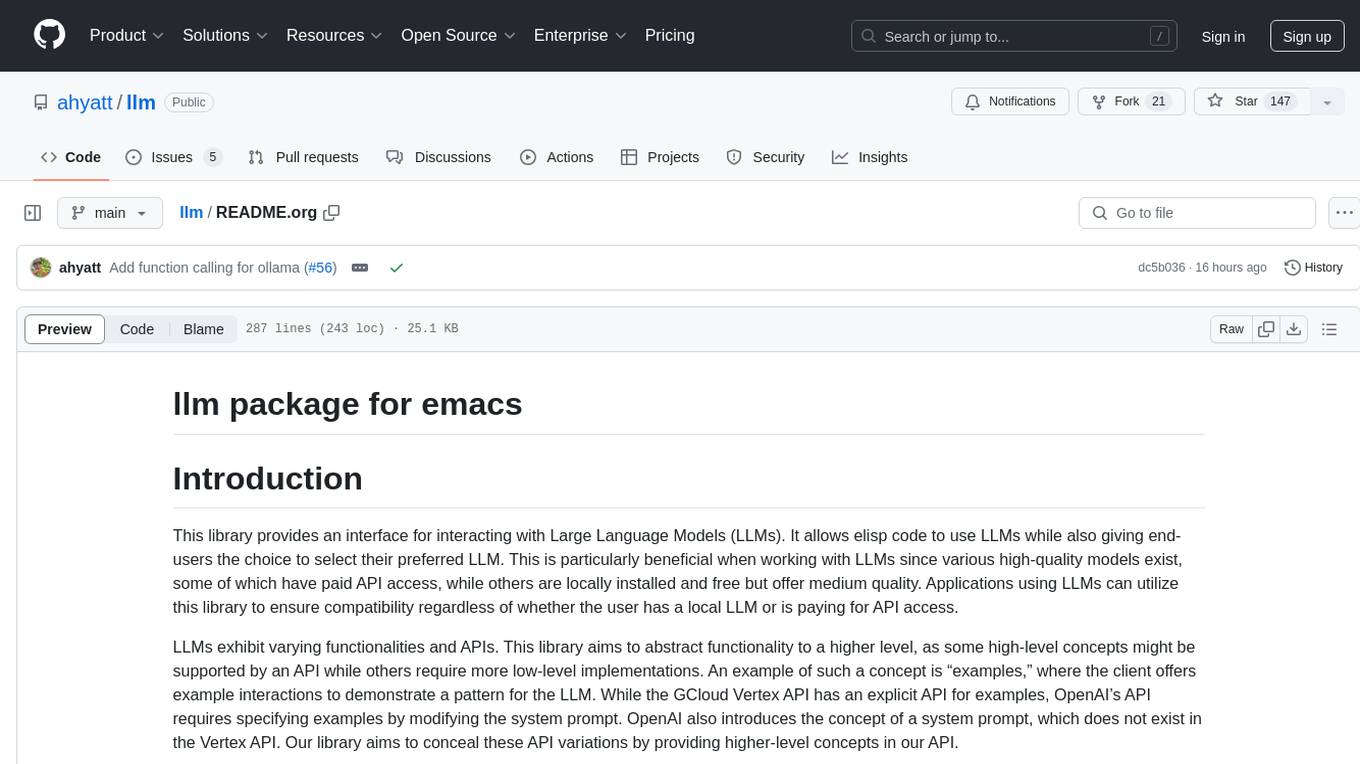
llm
The 'llm' package for Emacs provides an interface for interacting with Large Language Models (LLMs). It abstracts functionality to a higher level, concealing API variations and ensuring compatibility with various LLMs. Users can set up providers like OpenAI, Gemini, Vertex, Claude, Ollama, GPT4All, and a fake client for testing. The package allows for chat interactions, embeddings, token counting, and function calling. It also offers advanced prompt creation and logging capabilities. Users can handle conversations, create prompts with placeholders, and contribute by creating providers.
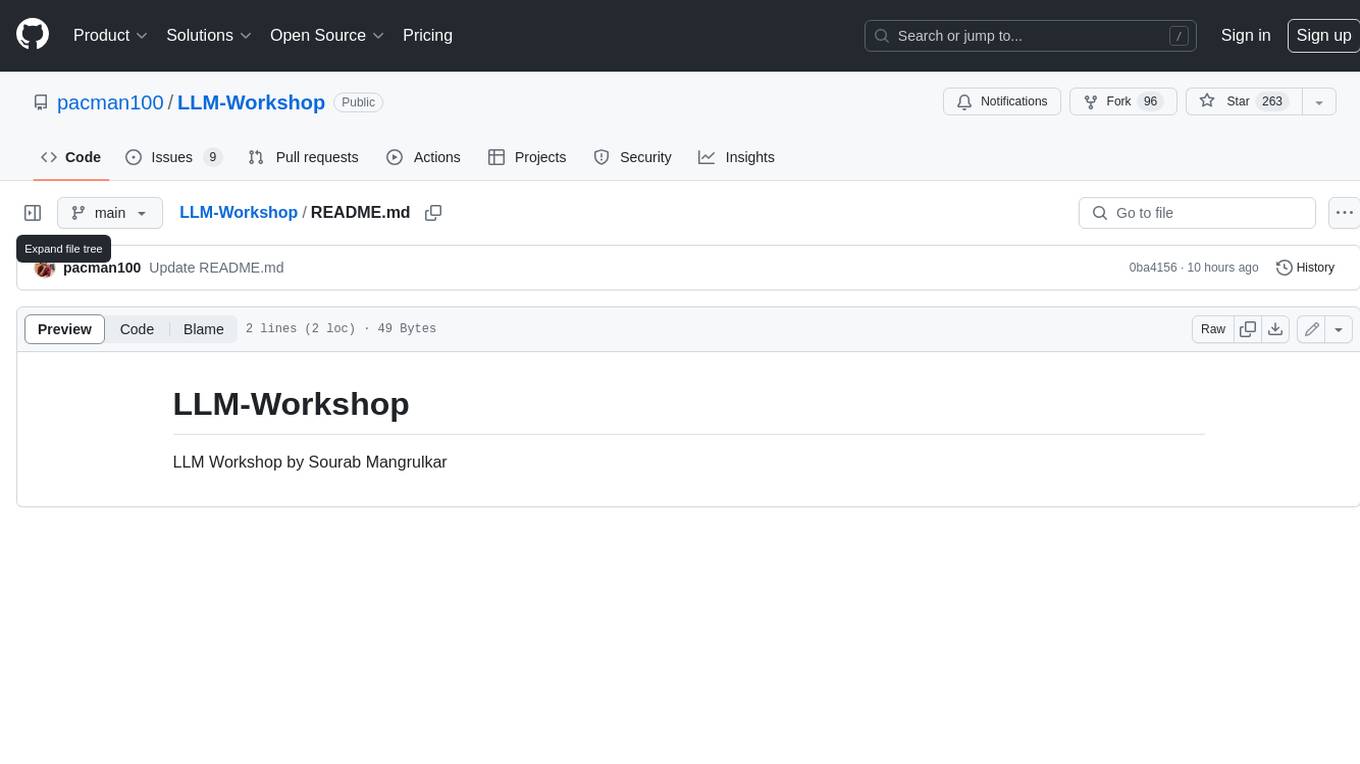
LLM-Workshop
This repository contains a collection of resources for learning about and using Large Language Models (LLMs). The resources include tutorials, code examples, and links to additional resources. LLMs are a type of artificial intelligence that can understand and generate human-like text. They have a wide range of potential applications, including natural language processing, machine translation, and chatbot development.
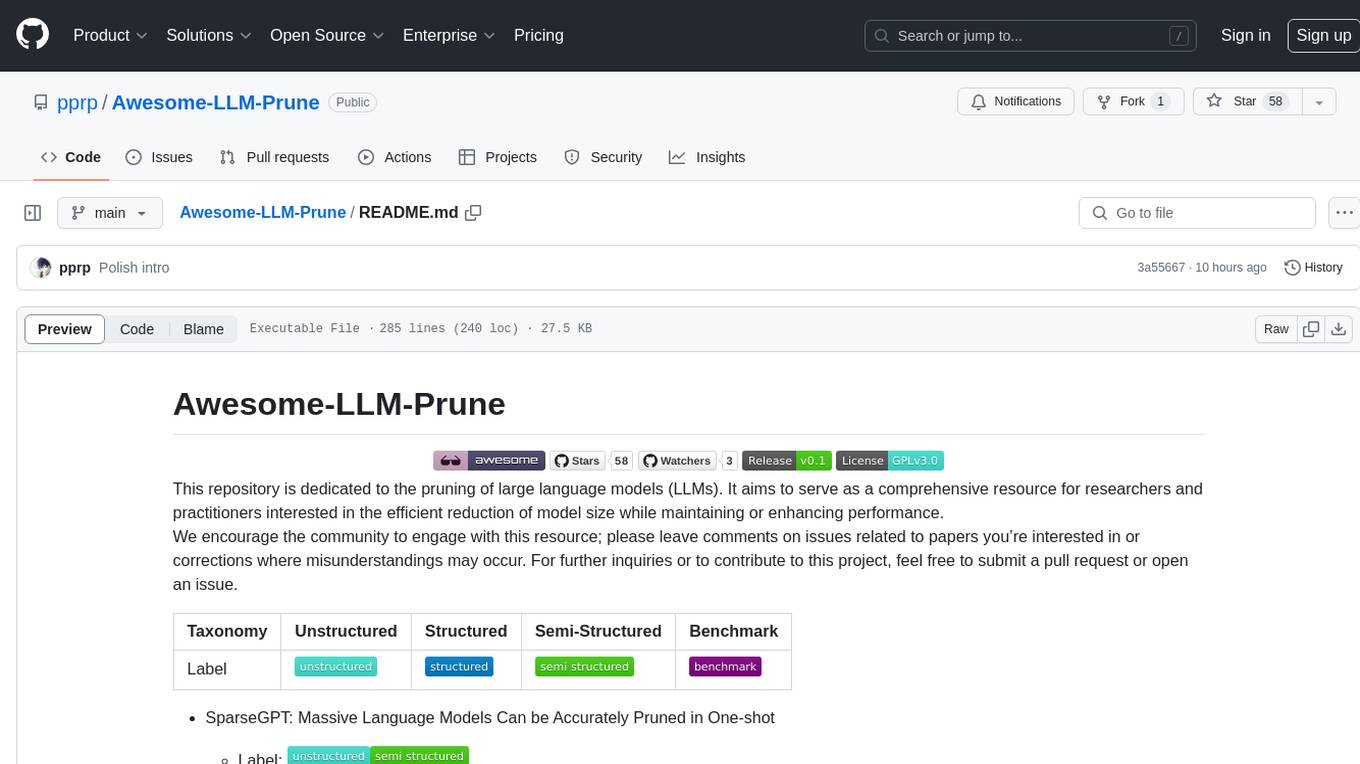
Awesome-LLM-Prune
This repository is dedicated to the pruning of large language models (LLMs). It aims to serve as a comprehensive resource for researchers and practitioners interested in the efficient reduction of model size while maintaining or enhancing performance. The repository contains various papers, summaries, and links related to different pruning approaches for LLMs, along with author information and publication details. It covers a wide range of topics such as structured pruning, unstructured pruning, semi-structured pruning, and benchmarking methods. Researchers and practitioners can explore different pruning techniques, understand their implications, and access relevant resources for further study and implementation.
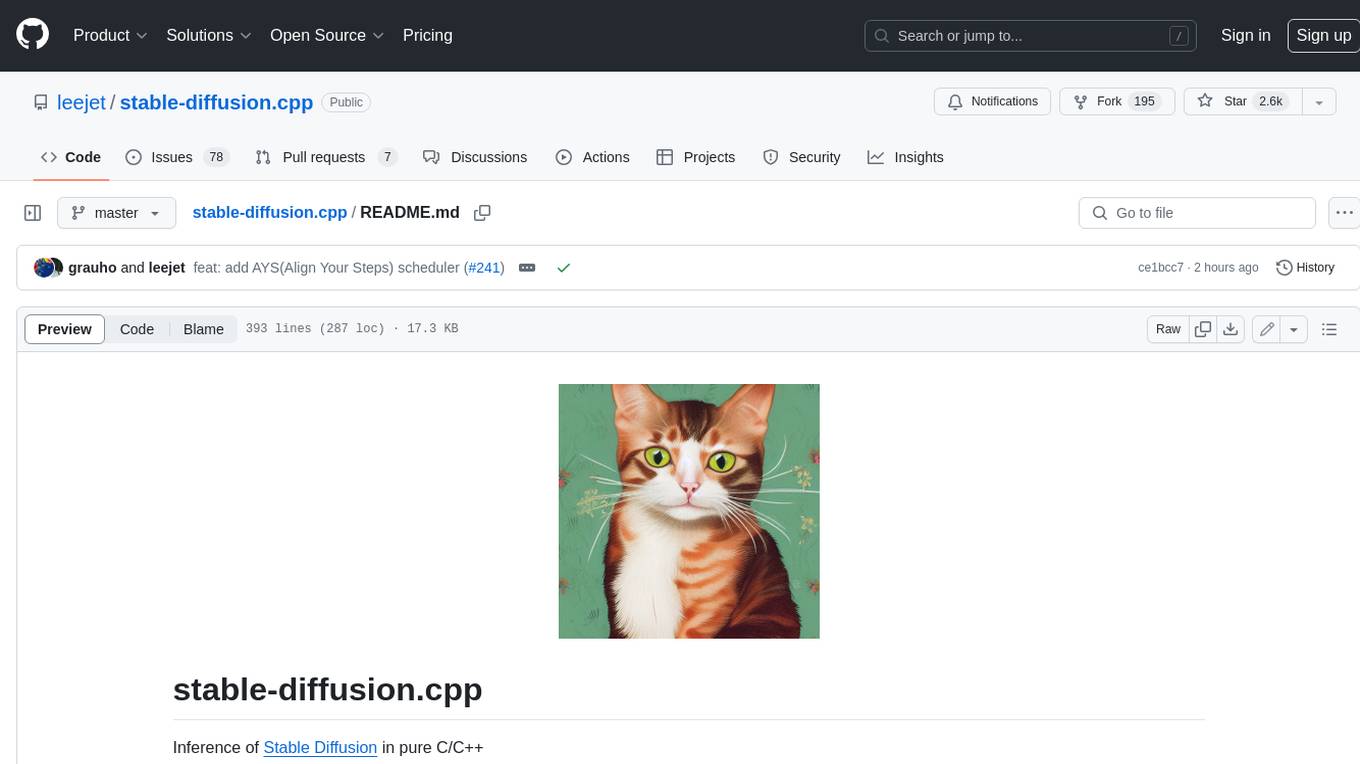
stable-diffusion.cpp
The stable-diffusion.cpp repository provides an implementation for inferring stable diffusion in pure C/C++. It offers features such as support for different versions of stable diffusion, lightweight and dependency-free implementation, various quantization support, memory-efficient CPU inference, GPU acceleration, and more. Users can download the built executable program or build it manually. The repository also includes instructions for downloading weights, building from scratch, using different acceleration methods, running the tool, converting weights, and utilizing various features like Flash Attention, ESRGAN upscaling, PhotoMaker support, and more. Additionally, it mentions future TODOs and provides information on memory requirements, bindings, UIs, contributors, and references.
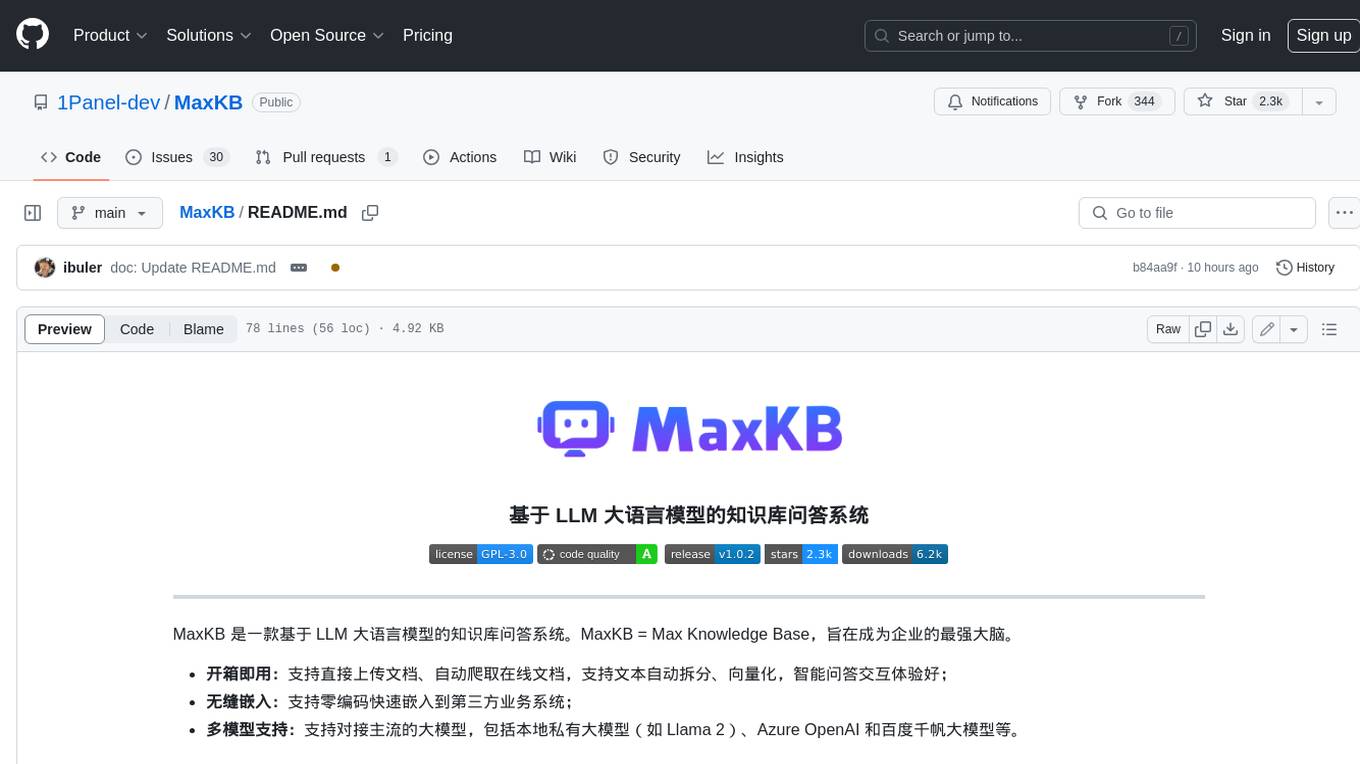
MaxKB
MaxKB is a knowledge base Q&A system based on the LLM large language model. MaxKB = Max Knowledge Base, which aims to become the most powerful brain of the enterprise.
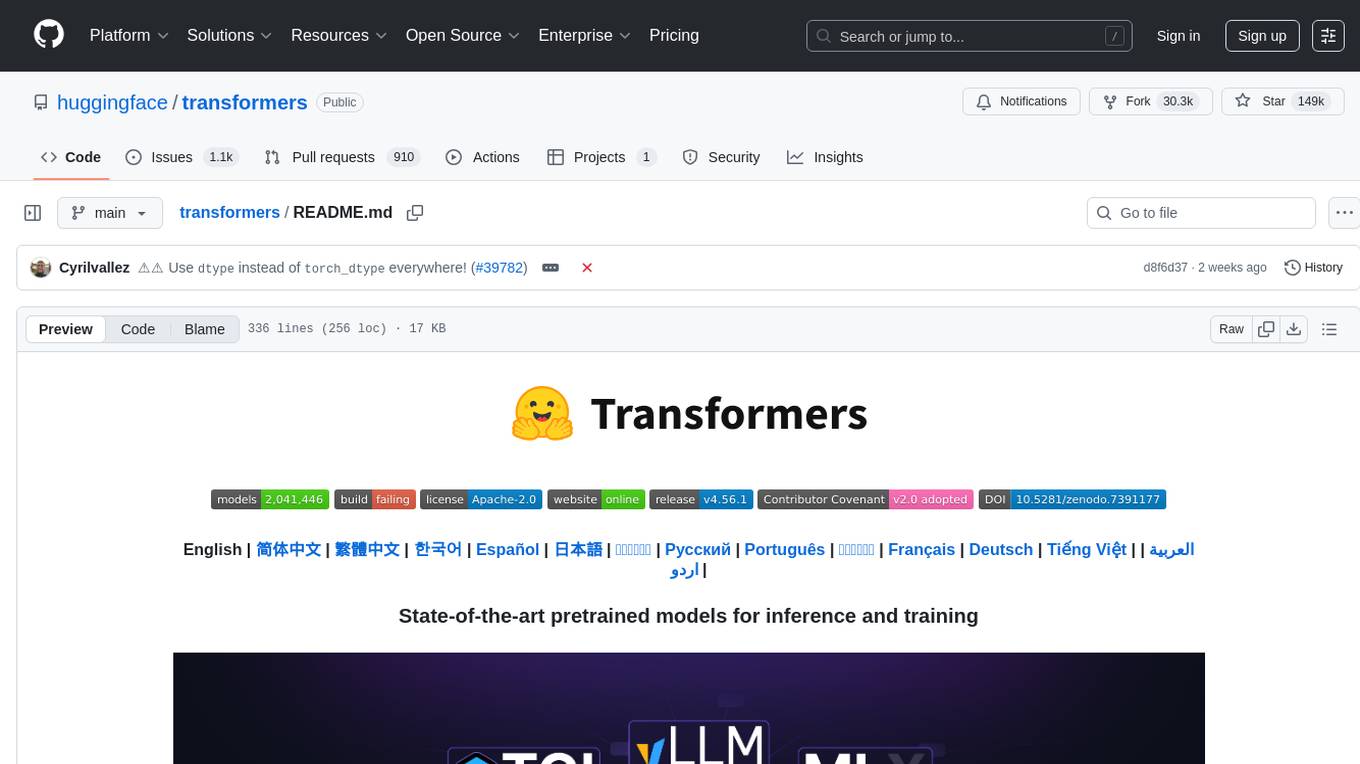
transformers
Transformers is a state-of-the-art pretrained models library that acts as the model-definition framework for machine learning models in text, computer vision, audio, video, and multimodal tasks. It centralizes model definition for compatibility across various training frameworks, inference engines, and modeling libraries. The library simplifies the usage of new models by providing simple, customizable, and efficient model definitions. With over 1M+ Transformers model checkpoints available, users can easily find and utilize models for their tasks.
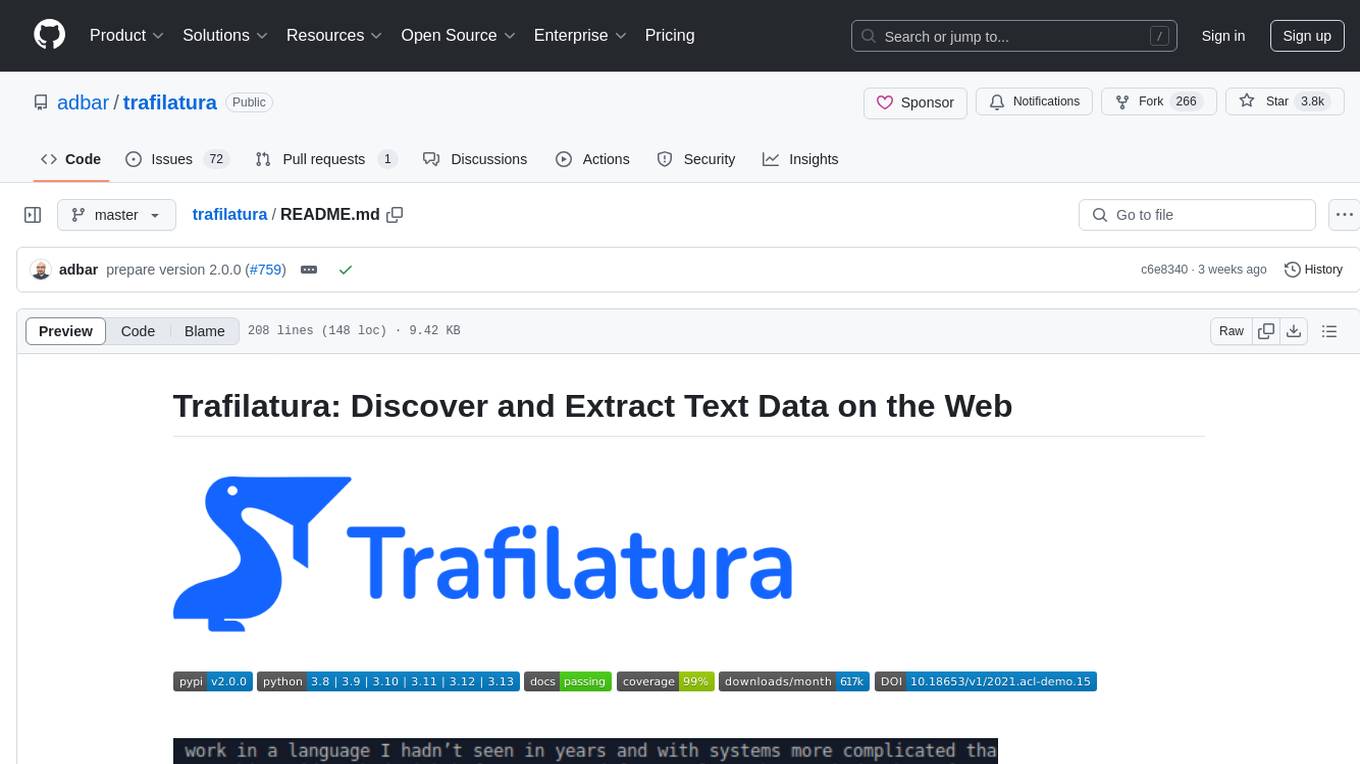
trafilatura
Trafilatura is a Python package and command-line tool for gathering text on the Web and simplifying the process of turning raw HTML into structured, meaningful data. It includes components for web crawling, downloads, scraping, and extraction of main texts, metadata, and comments. The tool aims to focus on actual content, avoid noise, and make sense of data and metadata. It is robust, fast, and widely used by companies and institutions. Trafilatura outperforms other libraries in text extraction benchmarks and offers various features like support for sitemaps, parallel processing, configurable extraction of key elements, multiple output formats, and optional add-ons. The tool is actively maintained with regular updates and comprehensive documentation.
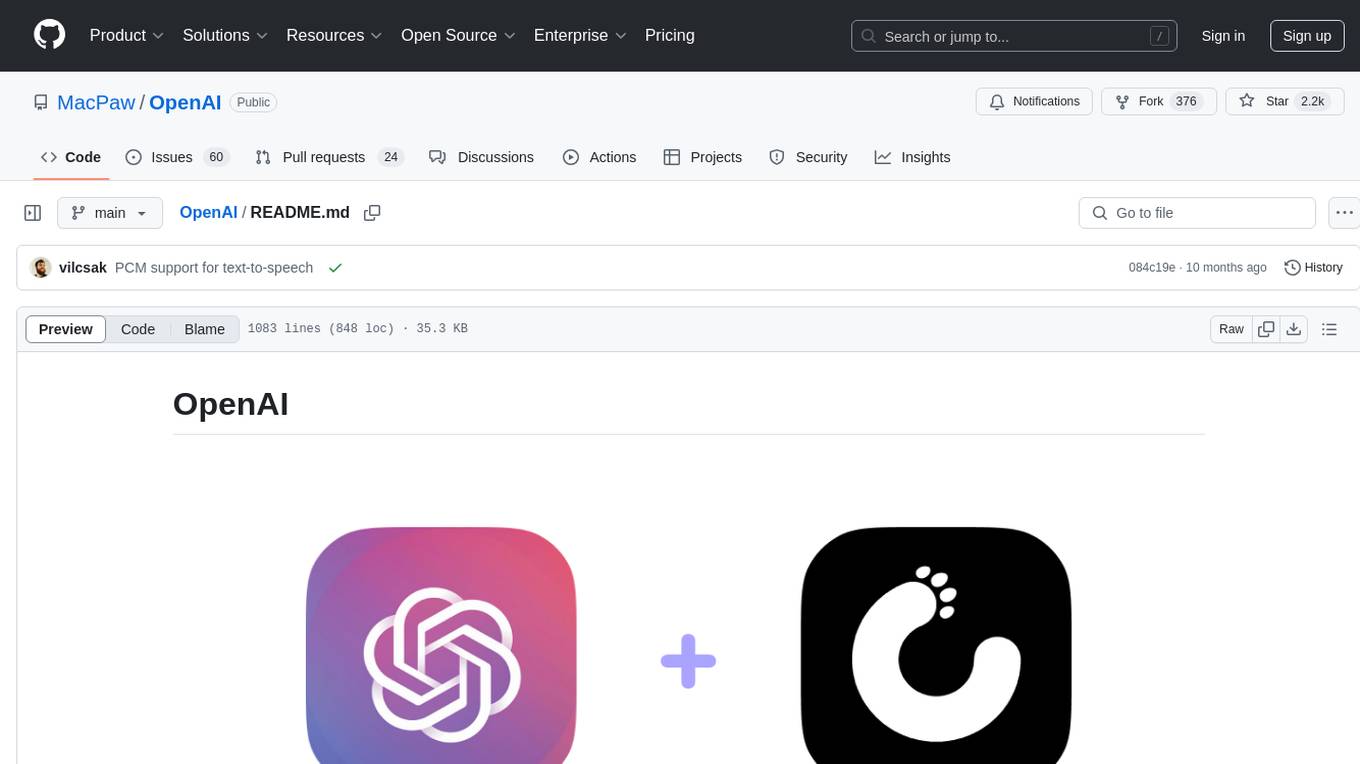
OpenAI
OpenAI is a Swift community-maintained implementation over OpenAI public API. It is a non-profit artificial intelligence research organization founded in San Francisco, California in 2015. OpenAI's mission is to ensure safe and responsible use of AI for civic good, economic growth, and other public benefits. The repository provides functionalities for text completions, chats, image generation, audio processing, edits, embeddings, models, moderations, utilities, and Combine extensions.
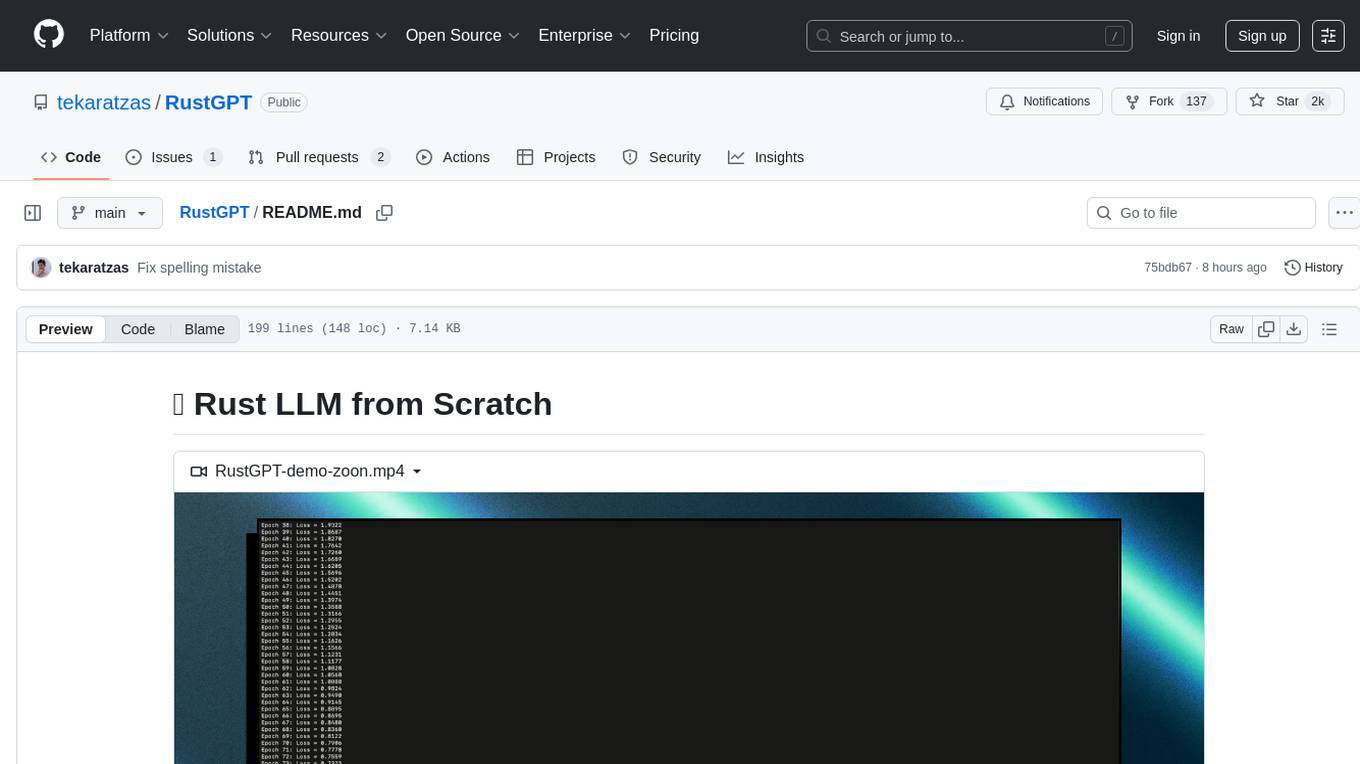
RustGPT
A complete Large Language Model implementation in pure Rust with no external ML frameworks. Demonstrates building a transformer-based language model from scratch, including pre-training, instruction tuning, interactive chat mode, full backpropagation, and modular architecture. Model learns basic world knowledge and conversational patterns. Features custom tokenization, greedy decoding, gradient clipping, modular layer system, and comprehensive test coverage. Ideal for understanding modern LLMs and key ML concepts. Dependencies include ndarray for matrix operations and rand for random number generation. Contributions welcome for model persistence, performance optimizations, better sampling, evaluation metrics, advanced architectures, training improvements, data handling, and model analysis. Follows standard Rust conventions and encourages contributions at beginner, intermediate, and advanced levels.
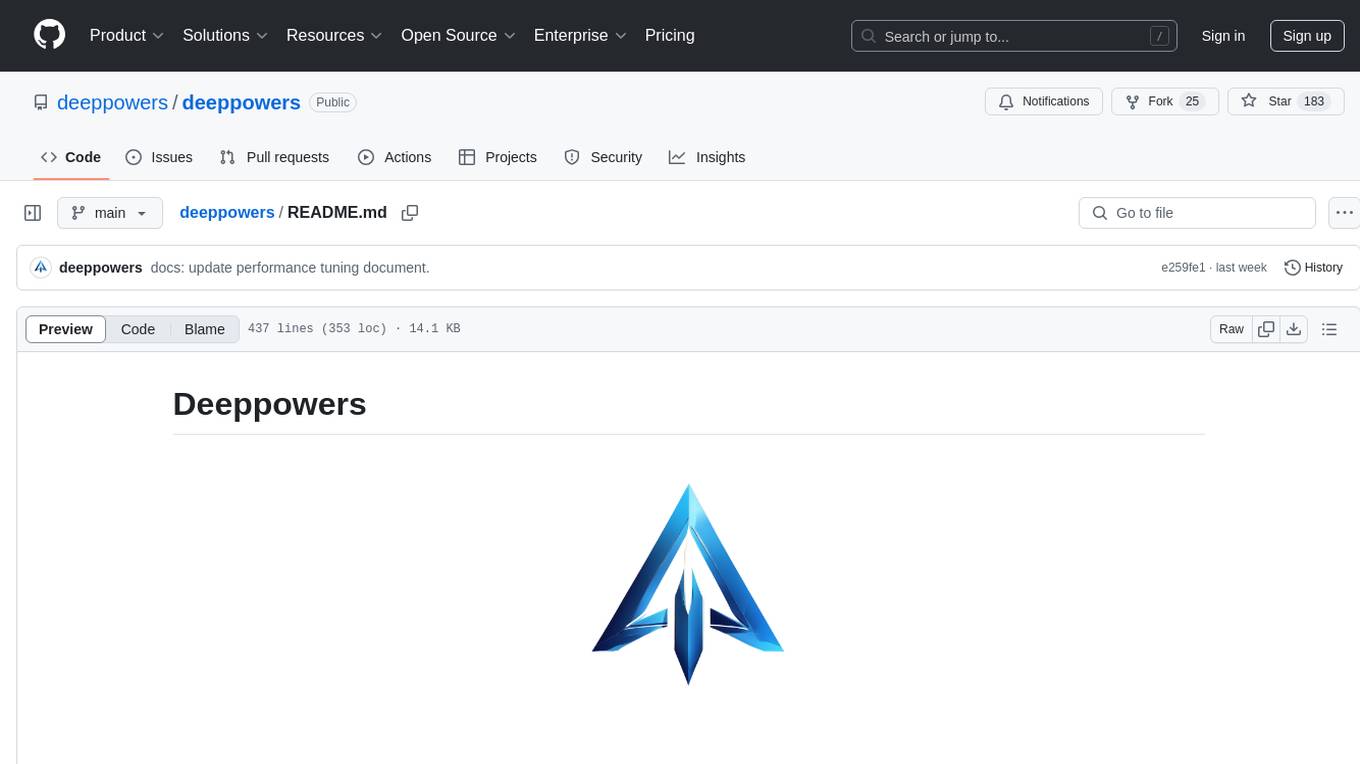
deeppowers
Deeppowers is a powerful Python library for deep learning applications. It provides a wide range of tools and utilities to simplify the process of building and training deep neural networks. With Deeppowers, users can easily create complex neural network architectures, perform efficient training and optimization, and deploy models for various tasks. The library is designed to be user-friendly and flexible, making it suitable for both beginners and experienced deep learning practitioners.
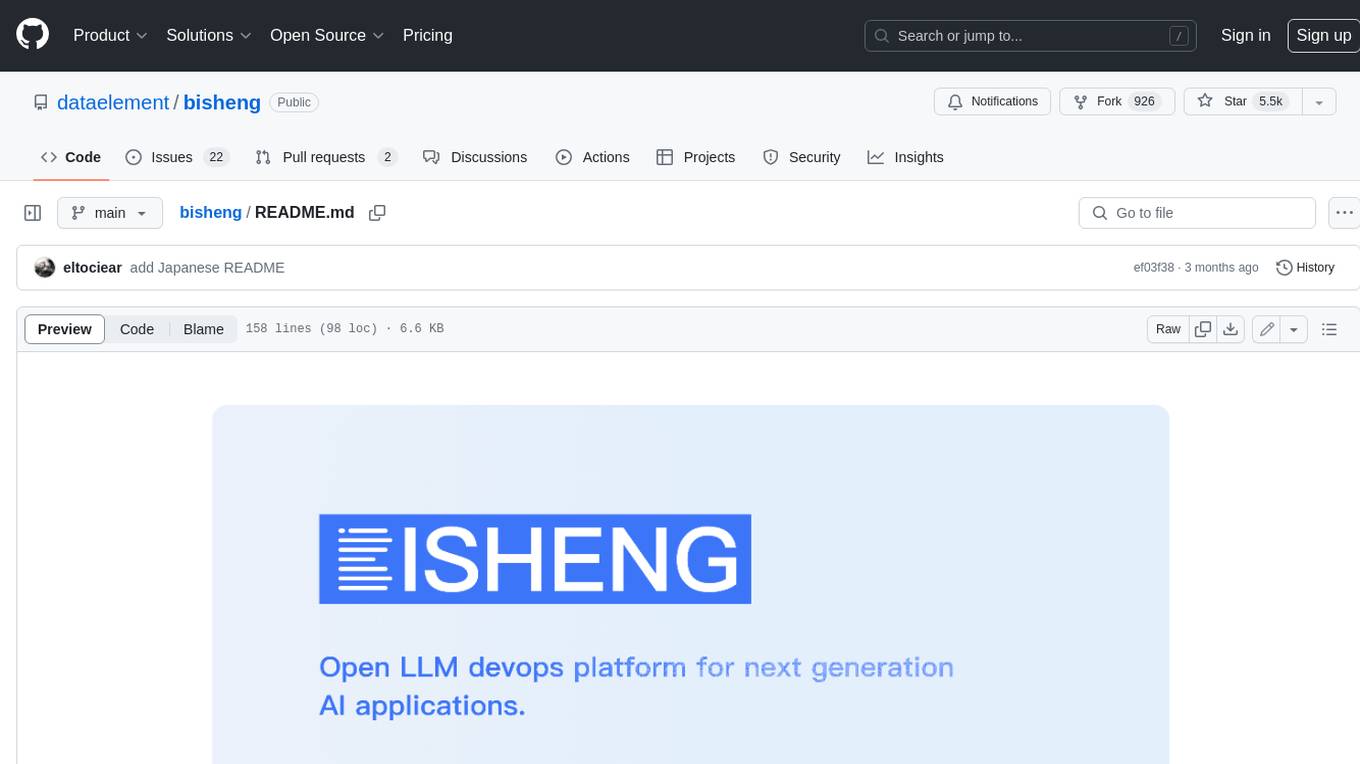
bisheng
Bisheng is a leading open-source **large model application development platform** that empowers and accelerates the development and deployment of large model applications, helping users enter the next generation of application development with the best possible experience.
For similar tasks

llama.rn
React Native binding of llama.cpp, which is an inference of LLaMA model in pure C/C++. This tool allows you to use the LLaMA model in your React Native applications for various tasks such as text completion, tokenization, detokenization, and embedding. It provides a convenient interface to interact with the LLaMA model and supports features like grammar sampling and mocking for testing purposes.
For similar jobs
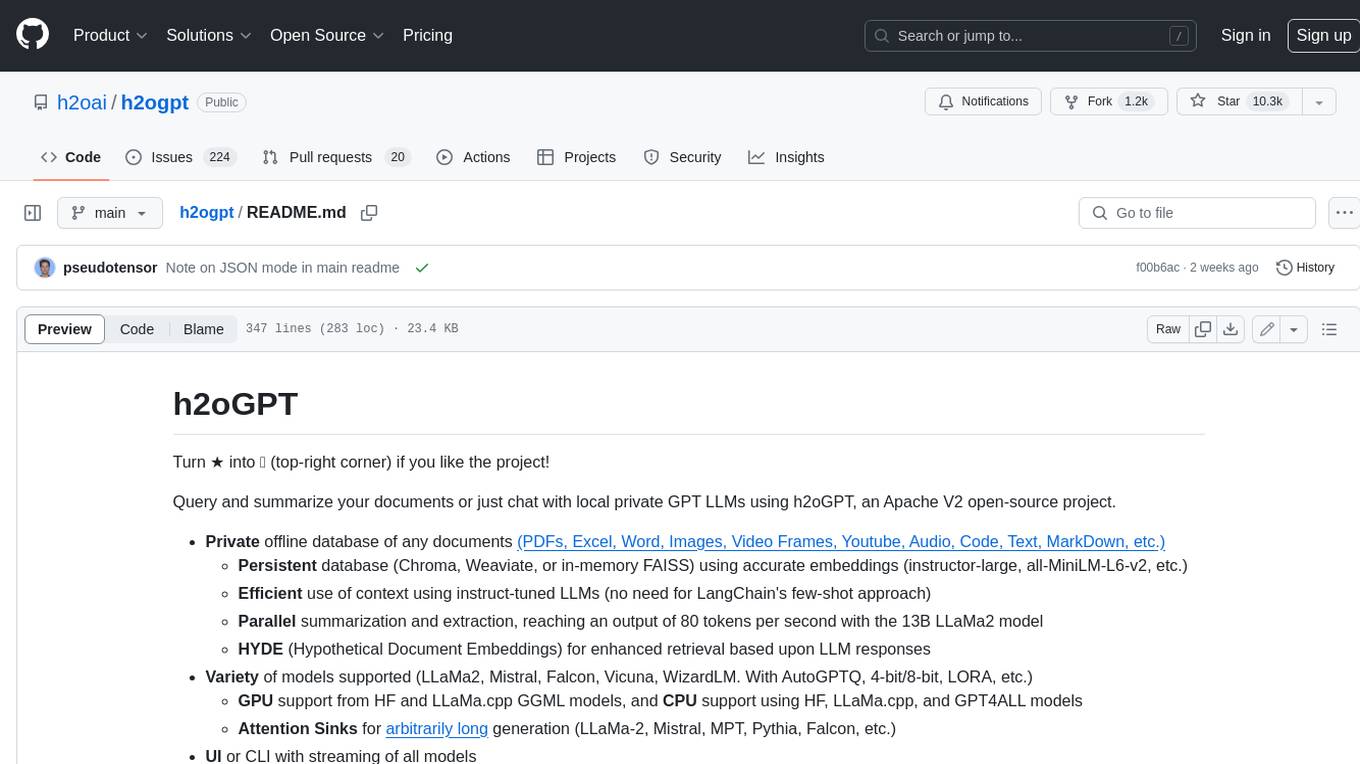
h2ogpt
h2oGPT is an Apache V2 open-source project that allows users to query and summarize documents or chat with local private GPT LLMs. It features a private offline database of any documents (PDFs, Excel, Word, Images, Video Frames, Youtube, Audio, Code, Text, MarkDown, etc.), a persistent database (Chroma, Weaviate, or in-memory FAISS) using accurate embeddings (instructor-large, all-MiniLM-L6-v2, etc.), and efficient use of context using instruct-tuned LLMs (no need for LangChain's few-shot approach). h2oGPT also offers parallel summarization and extraction, reaching an output of 80 tokens per second with the 13B LLaMa2 model, HYDE (Hypothetical Document Embeddings) for enhanced retrieval based upon LLM responses, a variety of models supported (LLaMa2, Mistral, Falcon, Vicuna, WizardLM. With AutoGPTQ, 4-bit/8-bit, LORA, etc.), GPU support from HF and LLaMa.cpp GGML models, and CPU support using HF, LLaMa.cpp, and GPT4ALL models. Additionally, h2oGPT provides Attention Sinks for arbitrarily long generation (LLaMa-2, Mistral, MPT, Pythia, Falcon, etc.), a UI or CLI with streaming of all models, the ability to upload and view documents through the UI (control multiple collaborative or personal collections), Vision Models LLaVa, Claude-3, Gemini-Pro-Vision, GPT-4-Vision, Image Generation Stable Diffusion (sdxl-turbo, sdxl) and PlaygroundAI (playv2), Voice STT using Whisper with streaming audio conversion, Voice TTS using MIT-Licensed Microsoft Speech T5 with multiple voices and Streaming audio conversion, Voice TTS using MPL2-Licensed TTS including Voice Cloning and Streaming audio conversion, AI Assistant Voice Control Mode for hands-free control of h2oGPT chat, Bake-off UI mode against many models at the same time, Easy Download of model artifacts and control over models like LLaMa.cpp through the UI, Authentication in the UI by user/password via Native or Google OAuth, State Preservation in the UI by user/password, Linux, Docker, macOS, and Windows support, Easy Windows Installer for Windows 10 64-bit (CPU/CUDA), Easy macOS Installer for macOS (CPU/M1/M2), Inference Servers support (oLLaMa, HF TGI server, vLLM, Gradio, ExLLaMa, Replicate, OpenAI, Azure OpenAI, Anthropic), OpenAI-compliant, Server Proxy API (h2oGPT acts as drop-in-replacement to OpenAI server), Python client API (to talk to Gradio server), JSON Mode with any model via code block extraction. Also supports MistralAI JSON mode, Claude-3 via function calling with strict Schema, OpenAI via JSON mode, and vLLM via guided_json with strict Schema, Web-Search integration with Chat and Document Q/A, Agents for Search, Document Q/A, Python Code, CSV frames (Experimental, best with OpenAI currently), Evaluate performance using reward models, and Quality maintained with over 1000 unit and integration tests taking over 4 GPU-hours.
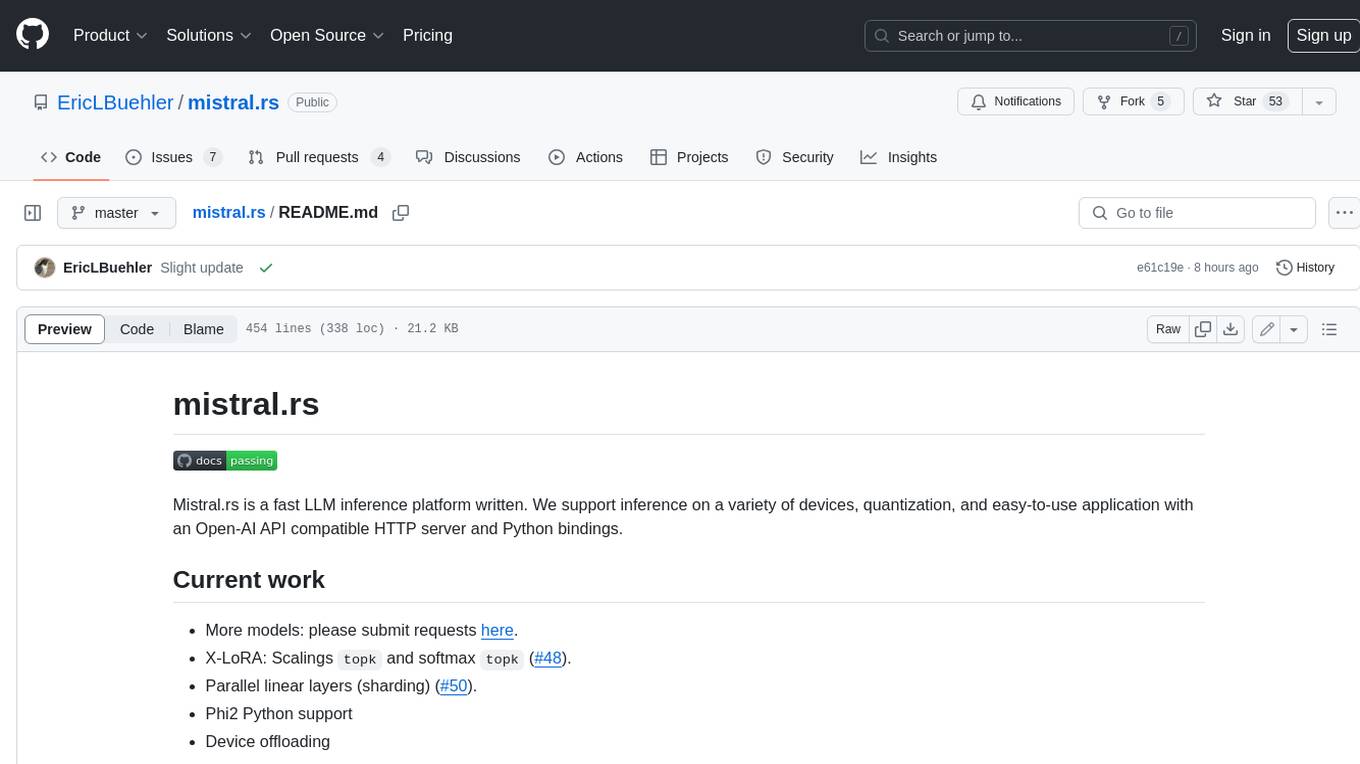
mistral.rs
Mistral.rs is a fast LLM inference platform written in Rust. We support inference on a variety of devices, quantization, and easy-to-use application with an Open-AI API compatible HTTP server and Python bindings.
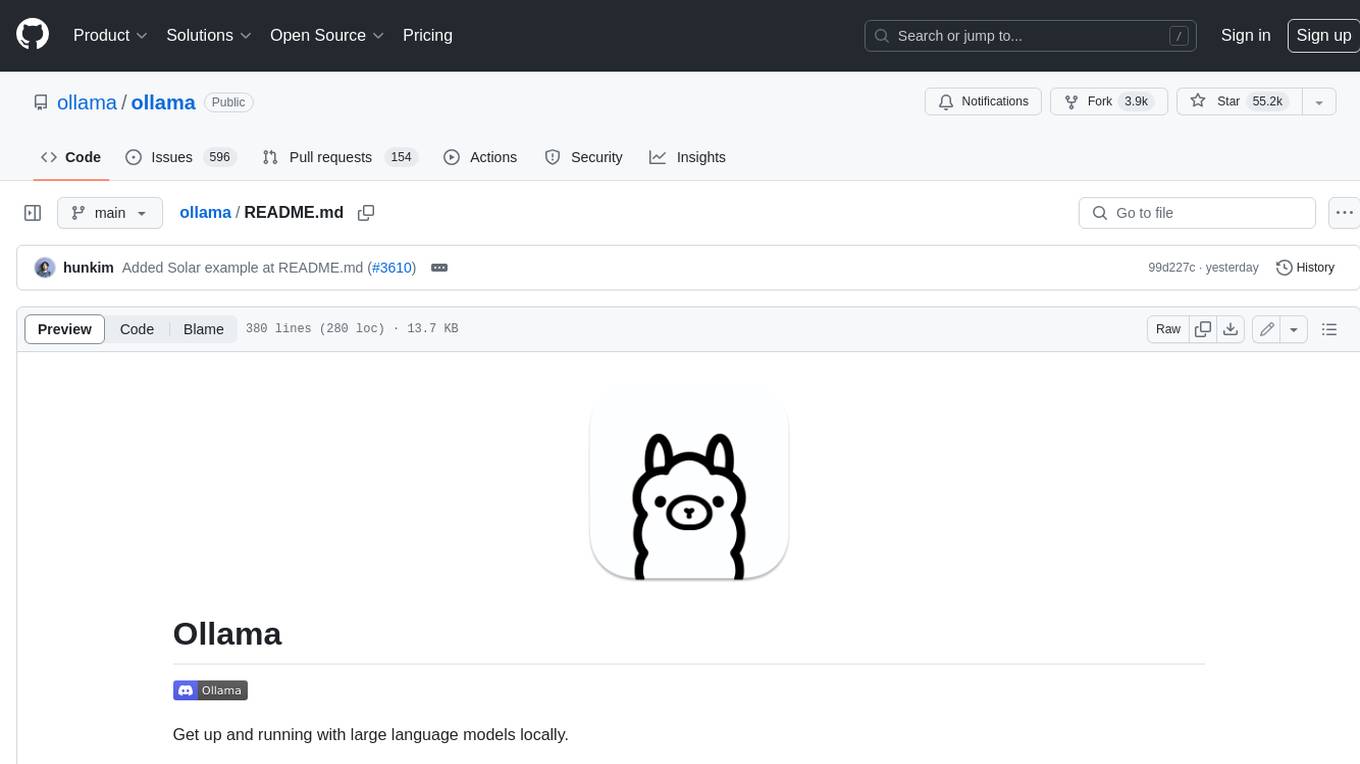
ollama
Ollama is a lightweight, extensible framework for building and running language models on the local machine. It provides a simple API for creating, running, and managing models, as well as a library of pre-built models that can be easily used in a variety of applications. Ollama is designed to be easy to use and accessible to developers of all levels. It is open source and available for free on GitHub.
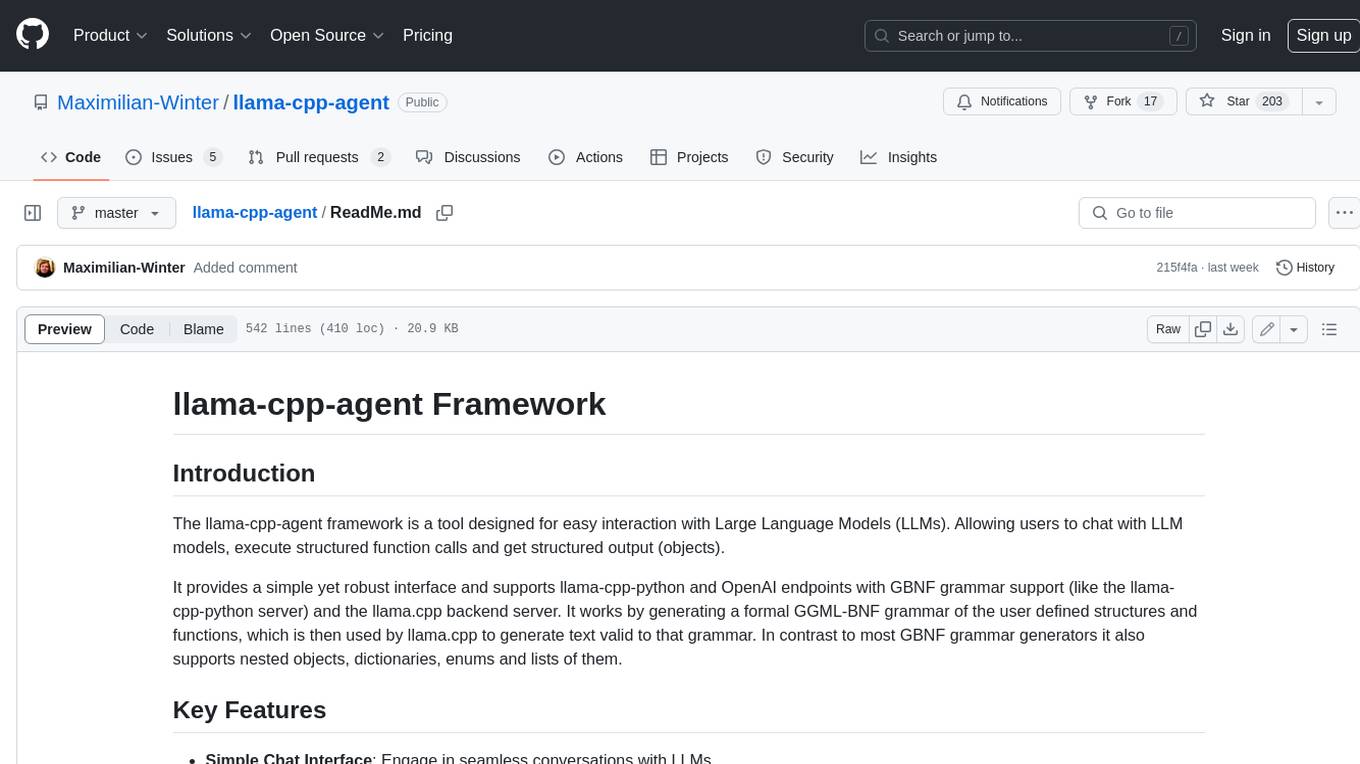
llama-cpp-agent
The llama-cpp-agent framework is a tool designed for easy interaction with Large Language Models (LLMs). Allowing users to chat with LLM models, execute structured function calls and get structured output (objects). It provides a simple yet robust interface and supports llama-cpp-python and OpenAI endpoints with GBNF grammar support (like the llama-cpp-python server) and the llama.cpp backend server. It works by generating a formal GGML-BNF grammar of the user defined structures and functions, which is then used by llama.cpp to generate text valid to that grammar. In contrast to most GBNF grammar generators it also supports nested objects, dictionaries, enums and lists of them.
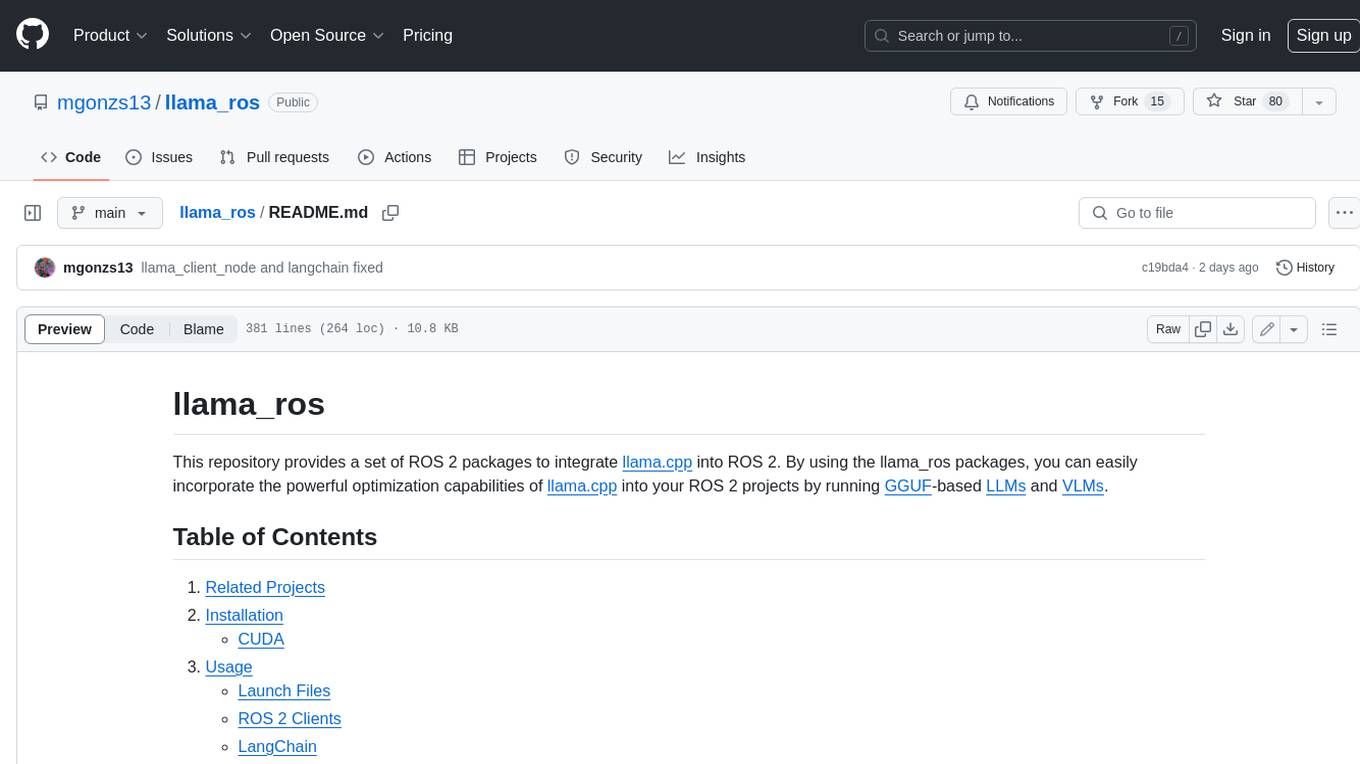
llama_ros
This repository provides a set of ROS 2 packages to integrate llama.cpp into ROS 2. By using the llama_ros packages, you can easily incorporate the powerful optimization capabilities of llama.cpp into your ROS 2 projects by running GGUF-based LLMs and VLMs.
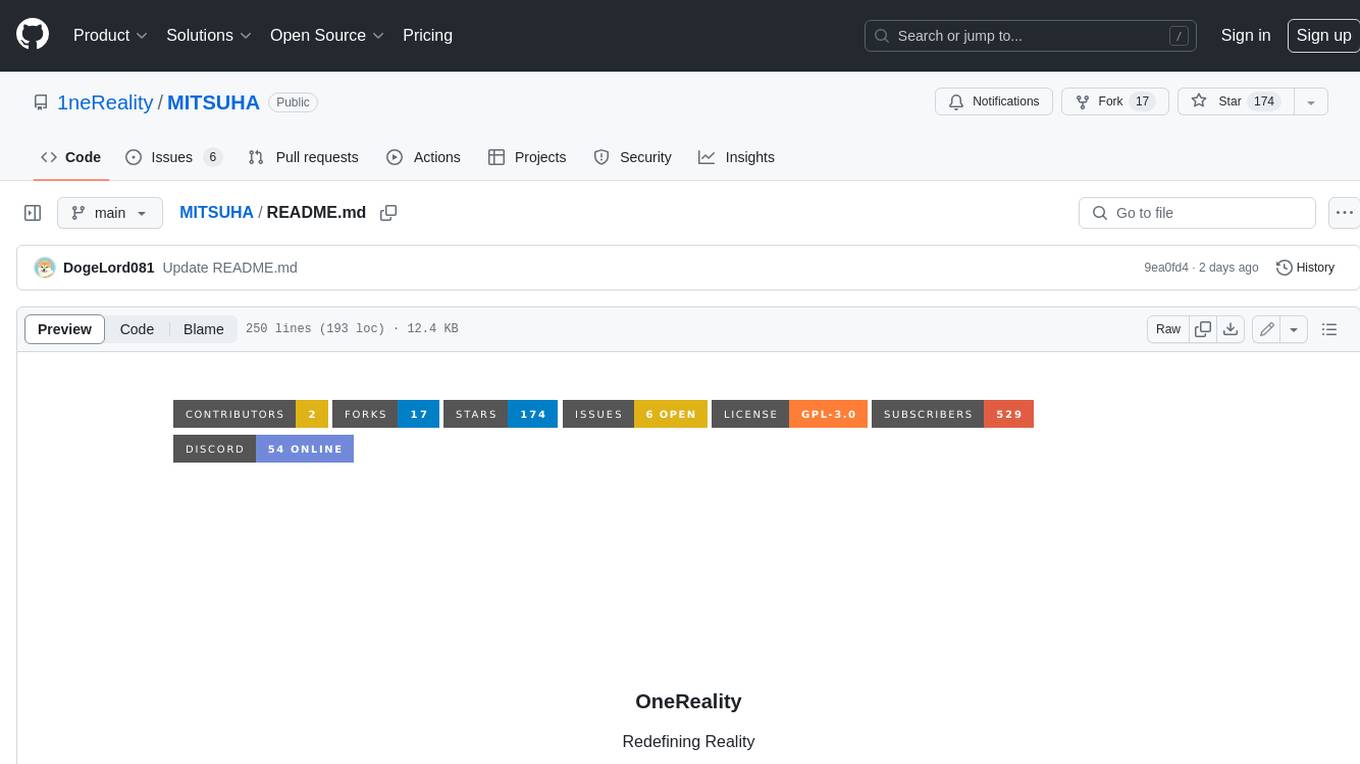
MITSUHA
OneReality is a virtual waifu/assistant that you can speak to through your mic and it'll speak back to you! It has many features such as: * You can speak to her with a mic * It can speak back to you * Has short-term memory and long-term memory * Can open apps * Smarter than you * Fluent in English, Japanese, Korean, and Chinese * Can control your smart home like Alexa if you set up Tuya (more info in Prerequisites) It is built with Python, Llama-cpp-python, Whisper, SpeechRecognition, PocketSphinx, VITS-fast-fine-tuning, VITS-simple-api, HyperDB, Sentence Transformers, and Tuya Cloud IoT.
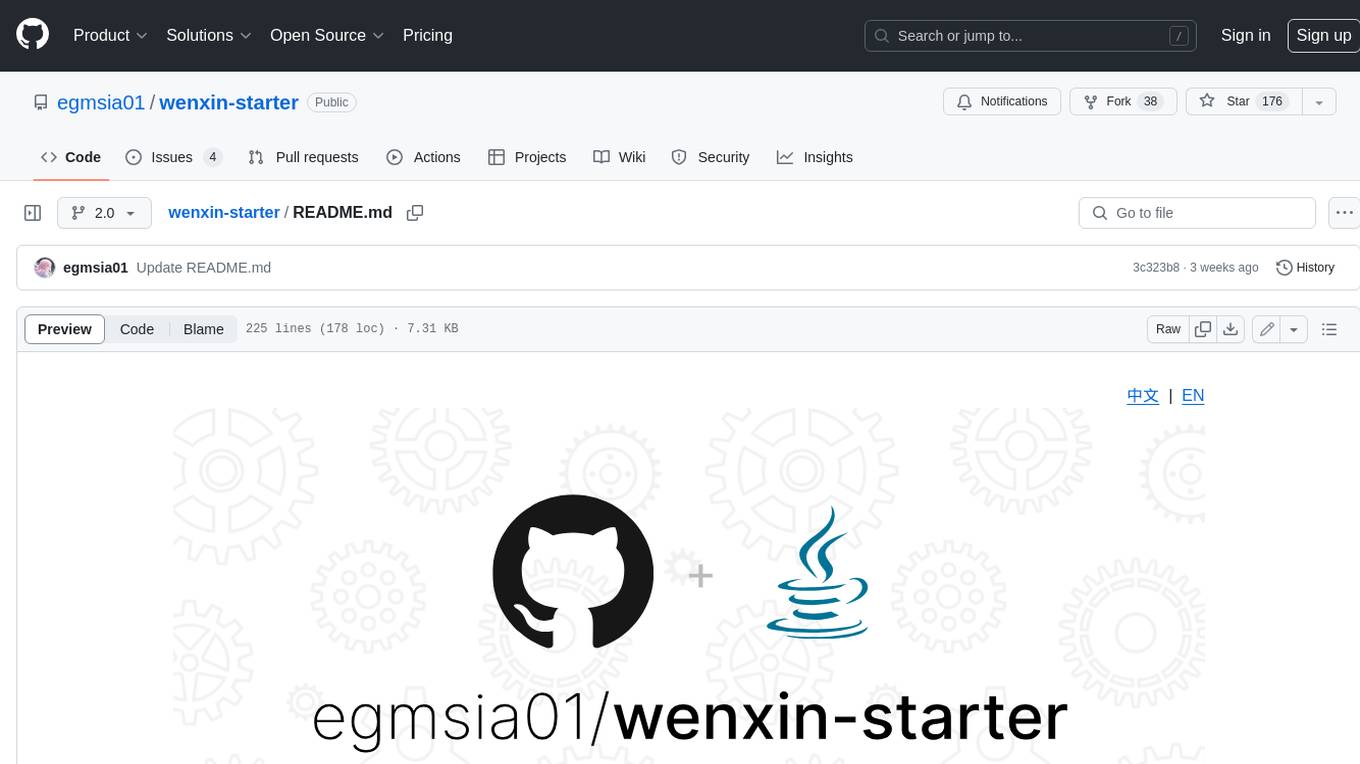
wenxin-starter
WenXin-Starter is a spring-boot-starter for Baidu's "Wenxin Qianfan WENXINWORKSHOP" large model, which can help you quickly access Baidu's AI capabilities. It fully integrates the official API documentation of Wenxin Qianfan. Supports text-to-image generation, built-in dialogue memory, and supports streaming return of dialogue. Supports QPS control of a single model and supports queuing mechanism. Plugins will be added soon.
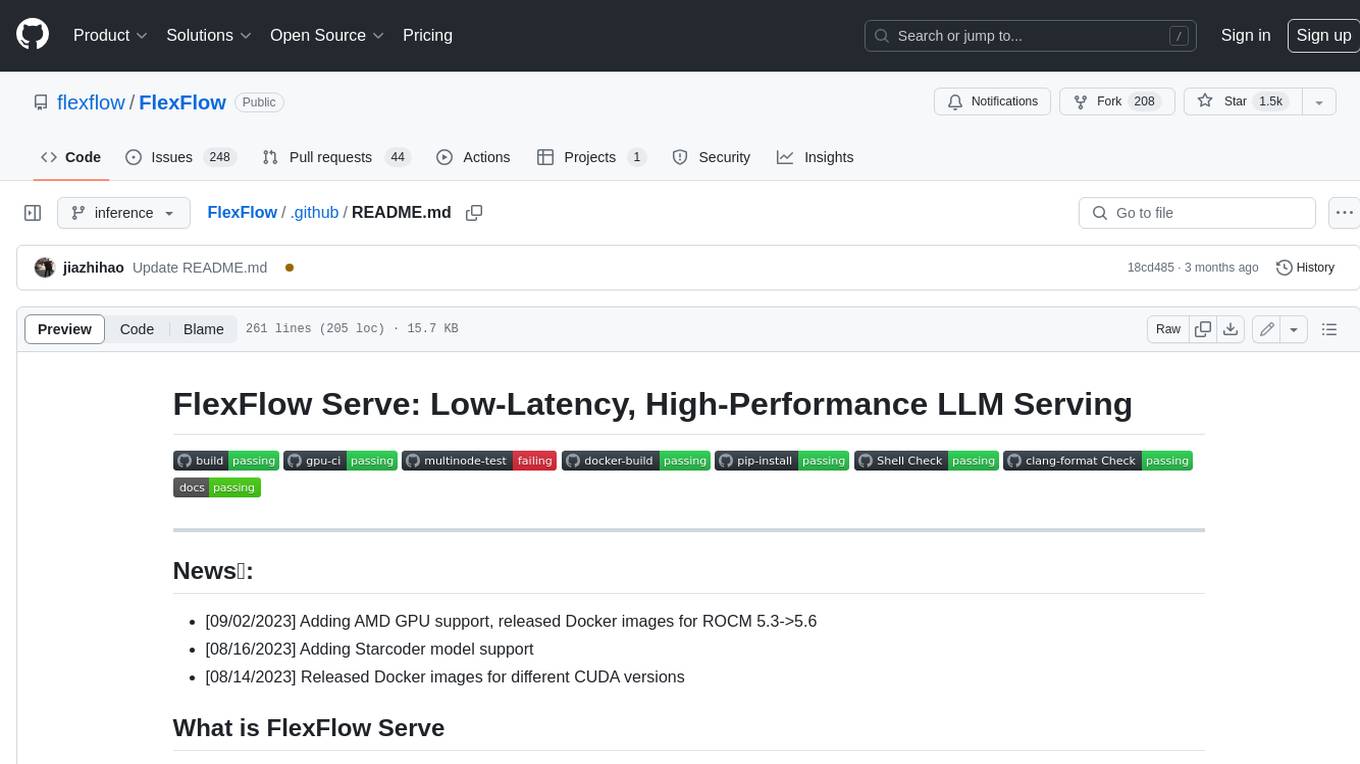
FlexFlow
FlexFlow Serve is an open-source compiler and distributed system for **low latency**, **high performance** LLM serving. FlexFlow Serve outperforms existing systems by 1.3-2.0x for single-node, multi-GPU inference and by 1.4-2.4x for multi-node, multi-GPU inference.

